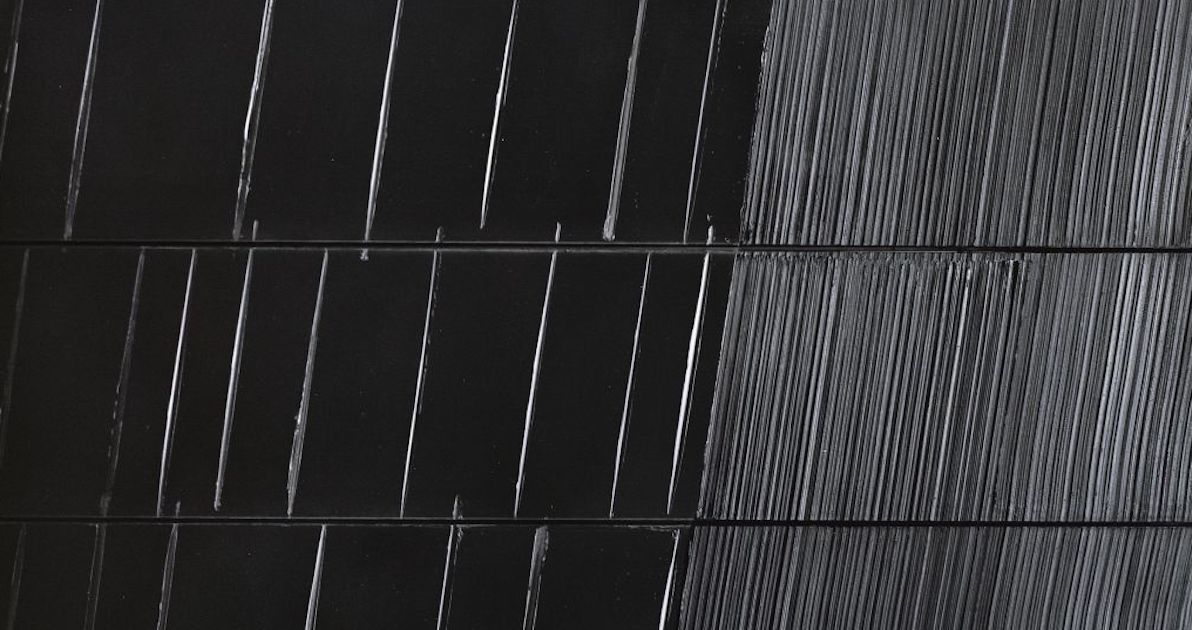Cette publication est également disponible en :
Français
The painter Pierre Soulages has just passed away on Wednesday, October 26, at the age of 102. His famous “outrenoirs” sometimes inspired perfumers, such as Thierry Wasser for his Néroli outrenoir at Guerlain, or Bertrand Duchaufour for Corpus Equus at Naomi Goodsir. One of the artist’s exhibitions at the Centre Georges Pompidou had also prompted the perfume creator Céline Ellena, also a member of the Nez collective, to write an olfactory chronicle that appeared in the fourth issue of Nez magazine, in October 2017.
At the Centre George Pompidou in Paris, Pierre Soulages is exhibiting his black artwork which is silent and sensitive. An immense white cube punctuates the end of the exhibition. I cross the threshold of this strange box and fall into the darkness of a projection room. On my left, among the immobile shadows leaning against the wall, I spot an unoccupied space and squeeze myself into it.
There are many of us. The lucky ones are sat in a line, shoulder to shoulder, on the few benches set out in front of the screen; the supple ones are sat cross-legged in irregular clusters on either side of the entrances covered by heavy strips of shiny fabric; the tough ones remain on their feet, scattered around the corners. The temperature is high, the atmosphere humid. I can see nothing. I can barely hear a sound. My nose is filled with the aroma permeating this pitch-black place. I find it extremely difficult to distinguish, and then separate, each piece of sensory information in the absence of any air flow.
At that moment, Soulages looks at us from behind the camera and exclaims, “It’s a bit hot, isn’t it?” while removing his jacket. The room chuckles knowingly and bodies suddenly start to stir, causing a slight turbulence. A draft of air rises which I capture. I smell fragments of worm- wood cut like a three piece suit, cedarwood chips, a rosary of coriander or caraway seeds, a branch of deliciously fresh green leaves, a tangle of bitter lianas, a ball of cotton fibres, a violet candy, a measure of baker’s yeast, three sprigs of lavender, a touch of vetiver which resembles black liquorice (or vice versa), almond paste, traditional soap, the stale smell of warm buttocks on plastic chairs, that of the fine moisture in people’s breath… Finally, chlorophyll expelled by two or three discreet ruminants.
Soulages continues his explanation of the outrenoir (beyond black). How black reveals its full diversity and tonality when skimmed with light: when the viewer moves around the canvas the black changes, although “it is made with the same black”. I savour this rare pleasure, nose amongst the evidence. I am suddenly aware that I am suspended in this fragrant magma offering an infinite number of random potential trajectories and layers that slide under my nose immersed in darkness.
Confined in the unusual setting of this projection room, the miasmas form a compact and impenetrable mass. This dark place condenses an apparently homogenous fragrance formed by spectators who freely surrender their olfactory fingerprints, adding to those of the preceding visitors. The flow of curious people who enter or leave, who look for a space to sit or to stand, creates a swell of heady, capricious waves. The analogy with the painter’s words amuses me. The movement of molecules creates nuances in the uniform mass, a “reflection on the surface of the colour black”.
Visual: Pierre Soulages, Peinture 293 x 324 cm, 26 octobre 1994, source: www.pierre-soulages.com








Comments